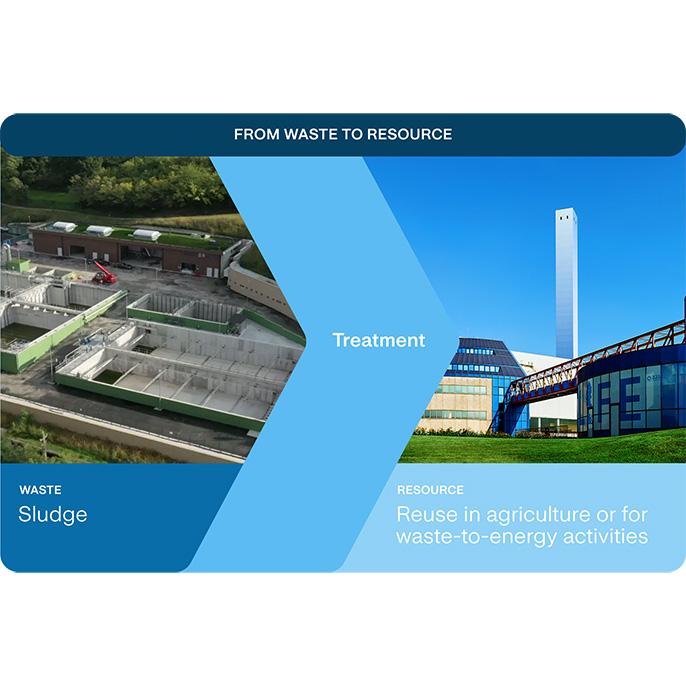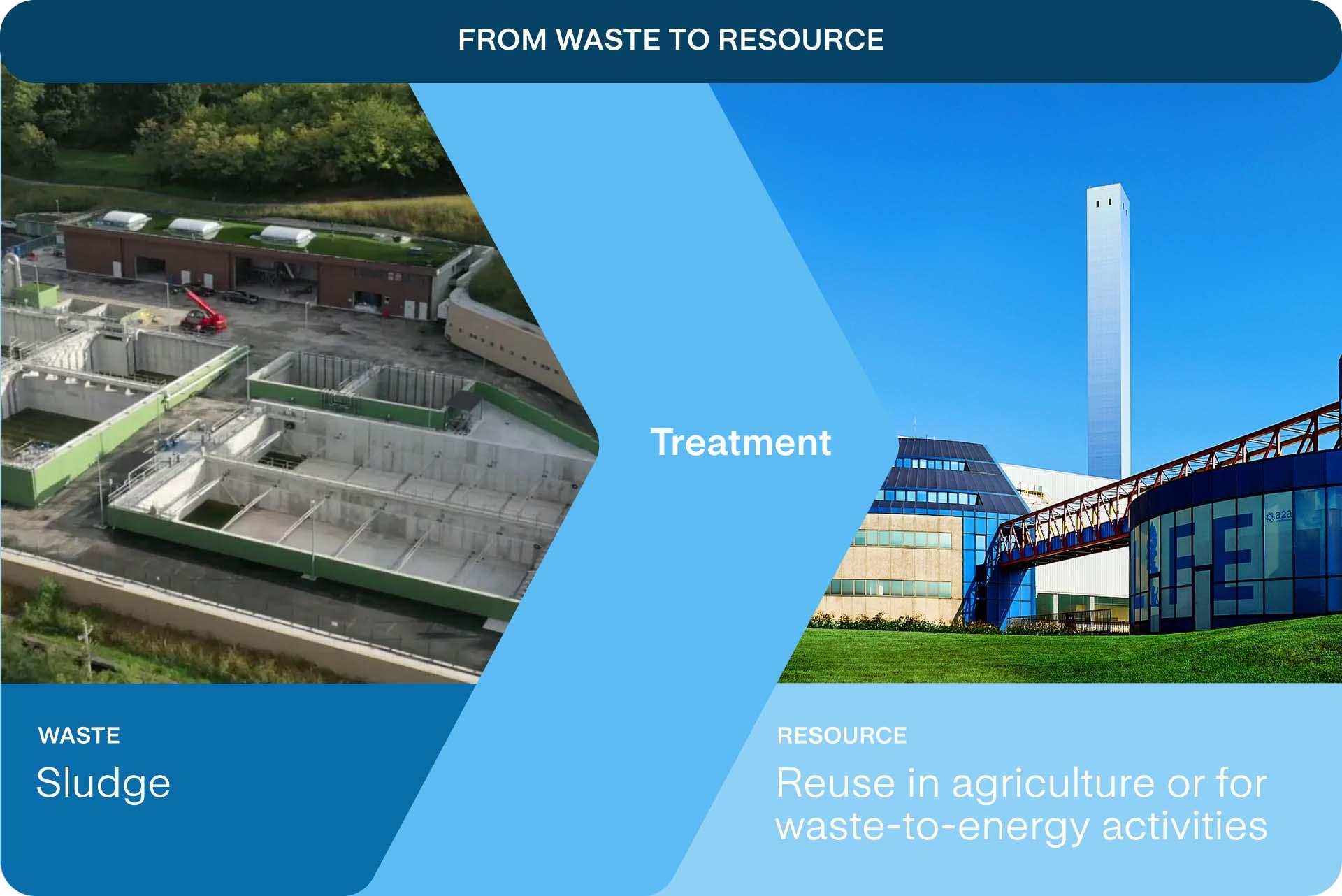Taking care of the territory means constant control over it. At A2A we are fully aware of this, which is why scientific verification of the impact of our work is a top priority for us.
The monitoring of sewage sludge, which can be used as fertiliser in agriculture or as a possible energy source if the sludge does not meet the criteria for recovery in agriculture, is the perfect example. That is why we have launched the FANGHILAB - Advanced Forms of Sewage Sludge Management in a Lombardy Innovative Hub - with the aim of testing new technologies to optimise material and energy recovery in a controlled manner and assessing their sustainability in a health, environmental and energy viewpoint.
The evaluation of the impact of the different sludge use strategies was entrusted to the Mario Negri Institute for Pharmacological Research, an independent organisation working in the field of biomedical research. Emilio Benfenati, Head of the Institute’s Environment and Health department, explained how the research was set up and what results it yielded.
The importance of health impact assessment
by Emilio Benfenati, Head of the Environment and Health Department - Mario Negri Institute for Pharmacological Research
In the FANGHI project, the effects of sludge used in agriculture or sent to waste-to-energy plants were considered. In the case of sludge spreading on agricultural land, most contaminants are released into the soil. From here they can reach surface water courses or the water table.
Directly from the soil, they can be transferred to plant or animal organisms. Crops can then be contaminated with the pollutants and be consumed by humans, or reach the animal through the feed and then reach humans. In the case of atmospheric emissions, the volatile contaminants released are dispersed, then fall back to the soil and surface water, and then follow the pathways described above.
An innovative method
In the project, we studied hundreds of pollutants, carrying out meticulous analyses to measure them, using sophisticated chemical-analytical methods. In addition, we performed biological assays to directly assess the effects of contaminants on plants and algae, micro-crustaceans and aquatic bacteria such as daphnia.
In the case of the chemical analyses, information is obtained on what is present in the sludge or emissions. In contrast, in the case of biological assays, harmful effects can be known directly. In addition, the data obtained from the laboratory tests were supplemented with the results of studies from scientific literature and databases.
For some pollutants, there is no information on their toxicological properties. In this case, we used predictive models (in silico methods with VEGA model). Even in the case of the migration of pollutants, from soil to groundwater or to the plant, and then into the animal or human, we have used models that simulate the behaviour in different cases.
Knowing the quantities of the pollutants, their environmental fate and effects, one can assess their impact, and thus make a judgement on the quality of the different types of sludge and their intended use. To do this, we integrated all results and compared them with standardised parameters or according to indications from the literature. Currently, not all pollutants analysed are regulated, and in that case we followed specific procedures for the assessment.
This provides judgements of the possible impact of sludge in different application scenarios: agricultural or waste-to-energy intended use.


The results of the evaluation
The results of the chemical characterisation of the samples analysed to fine-tune the model proved to be within the national and regional limits: suitability for spreading on agricultural land is evident, albeit with varying degrees of quality for the different sludge types studied. However, in the case of use on agricultural land, when the impact on the operator is taken into account, the results of the evaluation show that the risk acceptability criterion is not met for some types of sludge. For other population groups, there is no exceeding of the limit.
In the sludge-to-energy scenario, however, the risk acceptability criterion is always met.
In addition, tests on the sludge as such have shown significant phytotoxicity (seed germination) for some types of sludge. There are also ecotoxic effects on daphnia, algae and bacteria for various types of sludge. In contrast, when studying soils after spreading, the tests conducted did not show any toxicity in the samples analysed. Finally, modelling in soil showed that pharmaceuticals (human or veterinary) and perfluorinated compounds could show a risk due to estimated concentrations close to or even above the precautionary limit of 0.1 ug/L referenced from the legislation on pesticides. Figure 1 shows the estimated level of contamination in Lombardy, based on the concentration of the drug ciprofloxacin in the sludge and the characteristics of the soils.
The project not only provided results on the effects of sludge, but also developed a sophisticated set of methods and a specific index that combines the various results. The resulting scheme involves the measurement of contaminants, the use of calculation methods for risk assessment, the identification of acceptability criteria and incremental risk.
The use of bioassays (figure 2) allows an enrichment of this assessment. The results were combined in an index that makes comparison possible even in cases of different pollutants and exposures.
This is a multi-parameter risk and quality index that primarily assesses the cumulative risk effects of the mixture of pollutants considered and to which different receptors are exposed. The values obtained are compared with a continuous numerical scale, similar to that already adopted by the EPA and other international bodies.
During our experimentation within the FANGHILAB project, the Index was calculated considering the specific case of sludge and waste co-combustion (on a weighted basis: 30% dried sludge 75% s.s. - 70% Waste), comparing it with the index of a hypothetical case of a spreading on agricultural land in the same area of High Quality sludge as defined by RL DDUO 6665. In both cases, the risk threshold and/or quality limit value is complied with but, in the case of the analysed site-specificity, waste-to-energy is less impactful.
The ECO-SLUDGE chain
In a broader perspective, the FANGHILAB project was also an opportunity to strengthen the synergy between A2A and the many actors involved. A commitment that will also continue on other fronts, first and foremost the production chain “Eco-Sludge: ecosystem for a sustainable and innovative sludge management value chain”.
A working group active since 2020, accepted by the Lombardy Region as one of the project proposals for the development and consolidation of production chains and industrial ecosystems in the region. The chain brings together 18 players, including companies, research centres and associations involved in the management, treatment and analysis of sewage sludge.
Share your appreciation
Did you like the article? Let us know with a like!
Useful resources
Services


A2A S.p.A. - P.I. 11957540153
